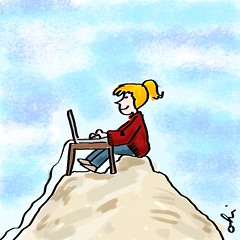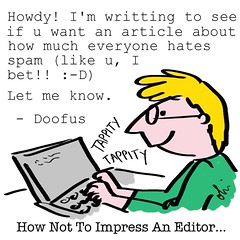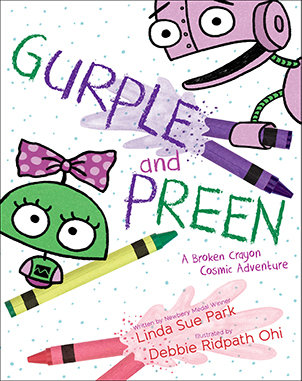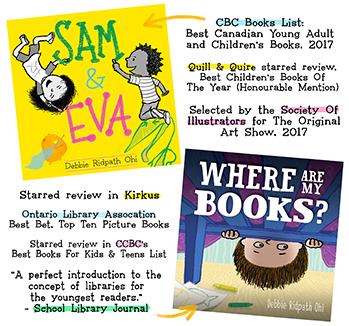If you'd like to see older WWFC strips, please check the Will Write For Chocolate archives or start from the beginning. You can also follow WWFC on Facebook, Pinterest and Google+. Thanks so much for your continuing support! -- Debbie
Useful online tools for freelance writers (Part 1)
Today's column focuses on online tools for freelance writers who work from home. One of the many blessings that the Internet has brought to freelance writers is the convenience of tools that save them time, money and desk space. This hit home recently when I was working in a coffee shop and was able to exchange several faxes with an interviewee for an article, e-mail my editor, look up a word in an online dictionary and do some research for another project...all in the space of the hour I spent in the coffee shop, with no physical paper or books; all I needed was a WiFi connection and my laptop.
Listed below are some of the online tools and services I've found invaluable in my freelance writing life. I'd be very interested in hearing about other online tools you've found useful; please do list them below and I'll post them in Part 2. For the next column, I'm more interested in tools of interest to freelance writers in general (which online dictionary do YOU use, for example?) rather than genre-specific research sites and tools. I'll save the latter for a future column.
 |
Gmail:
I was skeptical about this service at first...it seemed too good to be true because of the huge storage limits. I wish the mail storage had hierarchical folders and a more sophisticated filtering system, but I've still found Gmail to be reliable. I use Gmail as my public e-mail address and have also found it useful when I need to receive large attachments.
MyFax.com:
An online service which allows you to send and receive faxes by e-mail. I switched from MaxEmail after a great deal of research because I found that MaxEmail could not send faxes to some 800 numbers. The MyFax.com user interface is poorly designed and takes some getting used to, but so far I've had no trouble with the service itself. I like the fact that I have my own 866 number, so clients and editors can send faxes to me for no charge. I also like the fact that I don't need to keep a physical fax machine, and can send and receive faxes from anywhere.
Canadian postal rates and U.S. postal rates:
Though I prefer electronic correspondence, there are still many freelance writing markets whose editors prefer surface mail queries and submissions.
XE.net:
Currency conversion. As a Canadian freelance writer who writes mainly for non-Canadian markets, I find this free online tool extremely useful.
Goldline.net:
Long distance phone service. This has greatly reduced our phone bills. How it works: You stick whatever amount of money into your account. Before you call a particular long distance number, you call your Goldline number first. The recorded voice tells you how much money is left in your account, and you dial your number. You can use this service from any phone, including pay phones (there is a small fee for a payphone call).
Office Depot (or Canadian Office Depot):
I confess I'm an office supply junkie and can spend waaaaay too much time browsing an office supply store. Now I can feed my addiction online! Plus it's nice having someone deliver my reams of printer paper instead of having to lug it home myself; in Canada, delivery is free if you spend at least $50.
Vistaprint (or Canadian Vistaprint):
If you're looking for relatively inexpensive business cards and other promotional materials, this is a great service. Be sure to sign up for their special deals and news mailing list to get the best prices...you'll get a lot of mail, BUT some of their short-term promotions are very good. I once ordered a set of 250 business cards for about $7 through one of their 24-hour promotions, and that included postage and handling. I was getting tired of the somewhat tacky-looking perforated edges on my own self-printed business cards.
Backpack:
Online organizer. I liked this system so much that I opted for the paid service. I use this for keeping notes on projects and reminder notes as well as hooking up some of my Backpack pages to Writeboards which enable me to collaborate on book and article projects with other people online.
Do you use any other useful online services or tools for freelance writers? Feel free to suggest them below and I'll post them in my next column.
 online tools in
online tools in  Blog/news
Blog/news Writing Collaboration Profile: Cheryl O'Donovan and Tom Wolferman
This week's column is about writing collaboration for two reasons. Reason #1: I collaborated with Michelle West to co-author a short story for a DAW fantasy collection called Magic Tails and am in the early stages of possible book collaboration, so am especially interested in this topic right now.
I recently found out that writer/cartoonist Chery O'Donovan and writer Tom Wolferman co-authored The Estrogen Underground (A Better Be Writer Publisher, 2005), described on their Web site as "subversive humor for the woman over forty." Reason #2 for this column: It's my birthday today, and Cheryl's and Tom's book title definitely caught my eye for its relevance. :-)
Anyway, Cheryl and Tom kindly let me pick their brains about their collaboration process:
 |
How did you and Tom decide to collaborate?
Cheryl:
I can’t recall how the quote goes…something like, “Dying’s easy, comedy’s hard.” Doing comedy alone is hard. There’s no laugh track to measure that your humor’s working. I’d met Tom through a mutual business contact. We corresponded over the years with humorous and philosophical e-mails. I knew he had talent.
I felt “The Estrogen Underground” as a concept had merit, and knew he could help deliver something funny and insightful. We’re both older, too, more inclined toward Mad magazine, “The Daily Show” and old Dick Van Dyke reruns, and relate less to stuff like “South Park.”
Tom:
Cheryl and I had worked with a mutual business contact, but not directly with each other. We began corresponding via email and realized we shared similar interests in writing. Our senses of humor also were aligned. After several years of volleying humorous emails, Cheryl contacted me for feedback when she hatched the idea for "The Estrogen Underground: Reinvention." When a publisher responded to her query and samples, she asked if I'd be interested in collaborating on the book. Although we never had a prior working relationship per se, there was an existing comfort level and mutual respect.
What was the collaboration process? (e.g. how did you decide who did what, how much was in-person, by phone, e-mail etc.)
Cheryl:
Because this was our first collaboration ever, the process was a little scrambled and hectic – and heavily electronic. After creating a working outline, we each took sections. Tom would write up a section, e-mail it. Back at my home office, I’d illustrate and design, as well as write. Occasionally, we’d do phone calls. I’d often be working at 3:00 a.m., cackling like some madwoman in a cellar.
Sometimes, the whole loony process was hilarity in itself. In our e-mail subject lines were questions about female werewolves and Hollywood plastic surgeons. Far from normal. But we never claimed to be normal.
Tom:
Cheryl had a vision for the book from the start. She wanted the writing to be smart; the humor spoofy, but not crude or demoralizing. I've always shared that sensibility so it was a project that intrigued me. She also wanted portions of the book's humor to touch readers on a more personal level, through essays. We agreed that a somewhat self-effacing tone would allow the reader to better relate to us. Once a publisher was on board, Cheryl put together an outline of chapters and topics.
Based on this blueprint, I started feeding her a few additional concepts, ideas for satiric content, etc. Once the chapters were finalized, we then chose specific sections we thought we'd each have fun tackling. Because the book was targeting baby boom women, as self-described "token male" I was apprehensive at first in being able to find a voice in my personal essays that would be relevant to this audience.
The key was choosing topics that were authentic for me. Our collaboration took the form of emails and occasional phone conversations. Since we had never met prior, by the time the project moved forward we both agreed we would delay meeting in person until the book was completed. It makes for a quirky story. Our first momentous face-to-face encounter was at an American Airlines departure gate en route to the Texas Book Festival, prior to removing our shoes for security purposes.
 |
What problems did you encounter collaborating this way, if any? How
did you solve these problems, or at least get around them?
Tom:
Surprisingly, there were few problems in the collaboration process. I think if there is mutual respect between collaborators, and both are secure in their talents and abilities, it is possible to create a working relationship where sharing suggestions is not viewed as a personal attack. Though we are similar in work ethic and creative approaches, we don't always agree. That would be unrealistic. But we attempt to be honest with each other. We'll lobby for ideas we feel strongly about. But respectfully, without an agenda.
When it comes to the creative process, Cheryl is probably a better multi-tasker. She can juggle tirelessly. I like to focus on a topic, then move on to the next. We try to adapt to each other's styles. After years writing in business settings, advertising agencies and corporate environments, we've both had experience working as part of creative teams. They can be infested with high drama and self-serving motives. If you're both looking to create something for the good of the project, not personal ego, it can be a healthy, satisfying collaboration.
Cheryl and I are confident as writers, but somewhat ego-deprived. Neither one of us has any particular need to stand alone in the spotlight. Actually, either one of us is more likely to shove the other into the spotlight, breathe a sigh of relief, and wave happily from the sidelines. We are reluctantly learning how to navigate the rapids of self-promotion.
Cheryl:
By talking it out. We can disagree on what’s funny or effective. When that happens, we try to get an objective ("third party") opinion. We don’t ask for cotton ball feedback, either. We want people to be candid, if not brutally honest.
It’s hard sometimes, especially when deadlines loom. Under pressure, I can do a brain-freeze, and veer toward panic. Even then, you’ve got to stop, breathe and give each other space, if just for a few hours.
Finally, it’s also how you say it. Tact is a good thing. Tom and I have an appreciation for diplomacy, having both toiled under dictatorships. (Just kidding)
 |
What are the advantages of collaborating?
Cheryl:
Writing is an isolationist sport. As they say, you can’t write a novel by committee. However, you can become too insular. As collaborators, you’re not working in a vacuum. Creative people run the risk of becoming too self-satisfied, especially if they have success. For me, an overblown ego is the kiss of death. Once you think your stuff is untouchable, that’s when the inevitable decline begins.
People think they work best with people who are identical to them. What happens in that scenario? Usually the same old stuff. Think classics like Sid Caesar’s “Your Show of Shows” were written by the same flock of birds? No. Tom and I are different. Our styles complement each other. At least, that’s what it says in our press release.
Tom:
I think the advantages of collaboration are the excitement of conceiving an idea, building on it, shaping it, and ultimately developing it into something that breathes. It's the fun of the creative process, feeling free to bounce around ideas in the brainstorm stages, even the most ridiculous, eye-rolling concepts. If the give-and-take is safe, the results can be rewarding. And for those who loathe the publicity process, collaboration is the way to go.
We've had a blast promoting the book through online audio recordings, at the Texas Book Festival and at a recent signing at Barnes & Noble. I don't think it would have been nearly as fun going solo. The support really makes a difference. The camaraderie gets you through the rough spots.
What advice do you have for writers who are considering a collaboration project?
Tom:
I would say take some time to get to know the person. Set realistic goals. Talk about how you prefer to work. Give it a trial run and see how it goes. Have grounded expectations. Don't expect to agree, but agree to give and take. Let ideas marinade. It's all part of the process. And keep your sense of humor. Oh, and you'll want to know in advance what your collaborator looks like if you plan on meeting for the first time at an airport security checkpoint.
Cheryl:
Have some flexibility. Early on, discuss how you’ll resolve conflict, because they’re unavoidable. Listen to your collaborator’s opinions on your work, and vice versa. Respect how he or she works. I’m a tad ADD, and create in a cloudburst. Tom’s more methodical. So, everyone’s different. Some people get their engines revved in a group brainstorm. Others first work solo, then get together to discuss ideas.
You can find out more information about the book, including excerpts, at their Web site.
If anyone out there has other advice to offer on writing collaboration (do's and don'ts), please do post them below!
 cheryl o'donovan,
cheryl o'donovan,  collaboration,
collaboration,  interview,
interview,  tom wolferman in
tom wolferman in  Blog/news
Blog/news Freelance writers & e-mail: Part II
Make sure you use plain text
Steve Savitsky advises writers not to use the default font set in many mail programs. "Don’t use the default font' — set your mail program to send *plain text* rather than HTML. Many email users, especially the old-timers, automatically associate HTML mail with spam, and use mail readers that show plain text if there is any."
Avoid using acronyms
Mark Bernstein advises against using acronyms. "I’d say acronyms in general aren’t a great idea, even the ones that most people are likely to understand. Yes, I mean LOL and IMHO, but I also mean things as simple as BTW. (FYI has been around long enough in other contexts to be acceptable.) Never make the reader’s job harder, just to save yourself a few keystrokes."
Include context quotations
Several users disagreed with my advice to leave the conversation thread relatively intact at the end of your e-mail, but instead to use short context quotations. I find it depends heavily on the editor and on the writer, though of course I always cut off the annoying accumulated signature blocks at the end.
As a former editor, I preferred seeing the whole thread. I found that sometimes when writers only included selected bits, they sometimes didn’t select the bits I needed reminding about, which forced me to have to go back through my archives to find their older e-mails. I was generally corresponding with about 30-40 writers at a time.
When the thread got too unwieldy, I’d cut off the parts I didn’t need anymore. This is the method I use as a freelance writer now, leaving it up to the editor to control the thread. I always include the most recent/important info at the beginning of the message so the editor can ignore/delete the rest if they’d like.
When you do include bits of a previous thread, make sure you use the convention ">" to differentiate quoted text from the rest of the message. From Monica Cellio: "I get mail sometimes from people who interspersed their comments with the replied-to message, not using the conventional '>' to differentiate, and they say things like “see my comments in red below”. Your red is not my red, and if you make it too hard I’m just going to delete your message (if it was unsolicited) or send you a 'try again' note (if it was part of a conversation)."
Does your e-mail address and signature block give the right impression?
Monica also points out that writers should be aware of the impression given by their e-mail addresses. "Think about your choice of email address. I’ve seen people who already had ids like 'studmuffin' or the like send professional mail. That’s fine for chatting with your friends, but it doesn’t make a good impression in other contexts. Go to the trouble of getting a respectable From: line."
Readers advised against elaborate signature blocks, especially ones with cute ascii art or even clever quotes.
Be concise
Julie Duffy advises writers to be very brief and very clear about they want from the editor. "As publisher of a site about self-publishing, I receive emails from authors full of pages of information about their latest project, yet they never tell me why they are sending me the email. Do they want me to read their book? Buy it? Review it on my site? Proofread it for them? Who knows? Also, if you want an editor to take an action, mention that action: e.g. “Please email or call me if you would like to see the full article”. Make it easy for them to take the next step."
If your info is time-sensitive, ask for verification
Andrea Dale suggests including a contact phone number after your name at the end of your e-mail message. She also advises writers not to assume that e-mail is as reliable as the telephone. "If you are sending an attachment (with preapproval from the editor) ask them to send a simple 'got it' message when they receive the file, just so you know they got it (especially when you’ve got a deadline to meet)."
Never write anything in e-mail that you wouldn't say face-to-face
Also from Andrea: "While this doesn’t need to be mentioned most of the time, it’s an easy way remind yourself when you are frustrated with your editor, client, etc. and are tempted to send a snippy email."
Thanks for all the feedback, everyone!
Freelance writers and e-mail: keep it professional
The speed and convenience of electronic mail provides a major advantage in business correspondence, especially for freelance writers. Some people mistakenly assume, however, that the casual atmosphere in personal e-mail can carry over into one's business interactions with editors.
Here are a few tips on how to keep your freelance writing business e-mail professional:
Use a meaningful subject header. Don't leave the subject header blank. Choose a subject that clearly and concisely communicates the topic of the message. A breezy "hi" may cause the editor or the editor's e-mail program to discard your letter as junk mail.
When mailing to a large group, use the BCC: field. If you are sending an announcement to a group of people, put the recipients' e-mail addresses in the BCC: (blind carbon copy) field rather than the TO: field. That way if anyone does a direct reply, they will be replying only to you and not to the whole group.
Avoid fancy formatting. Even if your e-mail program offers extra formatting features like different font types, colors, and sizes, stick to the default font. The editor's e-mail program may not have the same features, and a letter that is impressive-looking on your monitor may be illegible on theirs.
 |
Don't use attachments unless you ask the editor first. With destructive computer viruses making the rounds on the Internet, many editors and freelance writers are wary about opening attachments. Always try to send your message within the body of an e-mail rather than an attachment. If your data is such that an attachment is necessary (such as in the case of a spreadsheet or Word document), always ask first.
Don't type in all caps. This problem is less prevalent than it used to be, but there are occasional newcomers to the Internet who don't understand that typing in all uppercase comes across as shouting in an e-mail message.
Proofread before you send. Sloppy spelling and grammar mistakes may convey a general impression of sloppiness to an editor. If your e-mail program comes with a built-in spellchecker, use it. If not, manually proofread your message.
Set the context. Never reply with an e-mail that says only, "Sure, that sounds fine to me." The editor is likely corresponding with many other freelance writers and may not remember the original context of your conversation thread, even if it only took place the day before. The best way to set the context is to include at least part of the message thread. If your message thread is lengthy, post it at the end of your reply rather than at the beginning; this will save the recipient from having to scroll down already-seen text to find your reply.
Keep your language business-like. Avoid using slang, emoticons (e.g. smiley-faces), or abbreviations that the other person may not understand.
Be concise. Get to the point quickly. Avoid using longer sentences. Take time to make sure you are explaining yourself clearly.
Sign your message. It's common courtesy to add your name at the bottom of the message. Don't assume that the recipient will be able to figure it out from the message headers.
Bottom line: For work-related correspondence, be as professional in your e-mail as you would in a regular letter.
Do you have any other tips to add to this list? Any e-mail pet peeves? Feel free to post them below.












